语法翻译法,直接法,听说法 ppt课件
语法翻译法直接法听说法
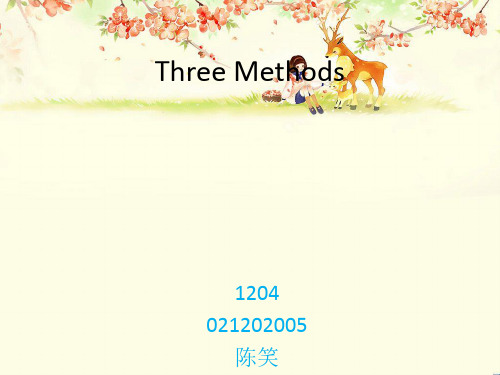
(2)Techniques ① direct association ② questions and answer exercises ③ conversation practice ④ error correction ⑤ dictation
(4)Inductive teaching of grammar
Three Methods
1204 021202005
陈笑
The Grammar-translation Method
• Background there is evidence that grammar analysis and
translation began to be the basic procedures in foreign language teaching from the 16th century.
②To enable the students to think in the target language.
③Pronunciation is paid attention to in order to form the beginning of a course . Vocabulary takes precedence over grammar.
(2)theory of learning The theory of learning underlying the
Grammar-translation Method was Faculty Psychology.
• Basic Principles
(1)main features
①Reading and writing are the major focus.
简谈外语教学方法(1)
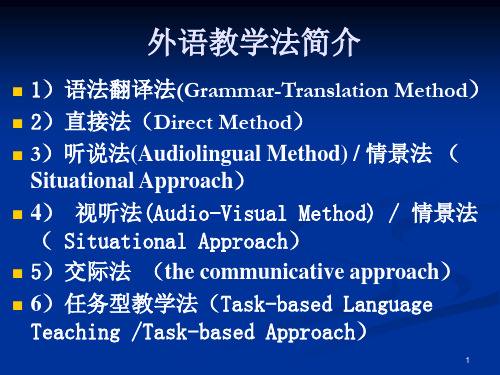
任务型教学法的优点
1)通过任务活动可以同时锻炼几种语言技能,有利于自动性的提高; 2)学生能接触到形式多样的语言,也可以根据需要使用自己的语言资源,
不但有利于词汇、句法和语篇等语言知识的学习,而且有助于提高语用能 力; 3)以学生为中心,交际活动多,语境自然,相关性强,有利于培养交际能 力; 4)活动多样,有助于激发学生的学习兴趣,易于保持学习的积极性,激发 动力; 5)活动内容涉及面广,信息量大,有助于拓宽学生的知识面; 6)任务有利于培养想象、思考、决策和应变能力和创造性思维,对课堂学 习和终身学习都有益。
由于这些优点,这种教学理论和方法受到广泛注意,也被引进我国。2000 年,教育部颁布《全日制义务教育普通高级中学英语课程标准(试验稿) 》,首次提出倡导‘任务型’教学途径。2003年,《普通高中英语课程标 准(实验稿)》再次明确提出要倡导‘任务型’教学,培养学生综合语言 运用能力。
12
其他外语教学法
2)意念和功能并不容易确定,例如标准、数量、顺序等问题 难以掌握;
究。
4)理论上对语言能力的认识还不够清楚,例如理论上是 competence,教学中是 proficiency,没有统一的框架。对 技能和自动性的解释也没有上升到理论高度。
9
在外语课堂上使用任务的做法并不新鲜,因为几百年来各种 教学法都是用任务的方法,类型包括翻译、造句、写作、调 查、复述、故事、标语广告、小册子、口头陈述、广播剧、 录像、网页制作、戏剧表演、讨论、问答等,但过去的任务 只是为了进一步练习和巩固所学的一种一种辅助手段,而现 在的任务则是一种占主导地位的课堂教学模式。
第二种关系是学生之间的相互信任的平等协作关系,课堂学 习通过互动活动进行。
教学活动包括翻译、小组活动、录音、听写分析、纪录课堂 感想、观察报告、自由交谈等。该教学法可以用于听说读写 等技能教学,但通常用于口语教学。
语法翻译法-直接法-听说法PPT演示课件

② Phase Two :reading/translation/analysis/ask questions
③ Phase three: write answers
8
• Summary and Comments (1)main advantages
have a better understanding of the meaning of abstract words and complicated sentences.
(2)theory of learning The theory of learning underlying the
Grammar-translation Method was Faculty Psychology.
4
• Basic Principles (1)main features ①Reading and writing are the major focus. ②Little or no systematic attention is paid to speaking or listening , because literary language is considered superior to spoken language and is therefore what language students should learn. ③The teacher uses the native language of the students as the main medium of instruction. The teacher emphasizes accuracy rather than fluency.
2
(2)the second impetus for the procedures of grammar analysis and translation in teaching Latin came from the social needs of European countries. (3)in the 19th century, more experts of foreign languages teaching adopted the strategy of combining grammar rules with translation.
外语教学法主要流派介绍ppt课件
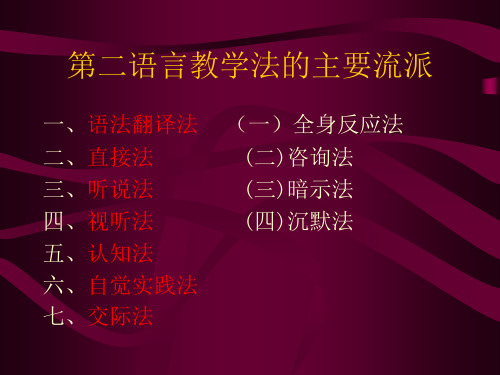
1、功能法产生的时代背景 威尔金斯《意念大纲》
( “Notional Syllabuses”,1978 )
2、功能法的理论基础 1)语言学理论基础 2)心理学理论基础
3、功能法的基本原则 1)以单元---学分体系组织语言教学 2)以功能意念为纲 考虑交际要素 3)教学过程交际化 4)基本目的语和专业目的语兼顾
日常交际 完整的交际活动 1、理论基础
1)语言习得理论 2)社会建构理念 3)课程理论
2、教学原则与特点 原则: 1)言语、情景真实性 2)形式---功能性 3)任务相依性 4)做中学 5)脚手架
特点: 1)目标 2)教师的输入 3)教学技巧与方式 4)教师角色 5)学生角色 6)评价方式与内容
第二语言教学法的主要流派
一、语法翻译法 二、直接法 三、听说法 四、视听法 五、认知法 六、自觉实践法 七、交际法
(一)全身反应法 (二)咨询法 (三)暗示法 (四)沉默法
一、语法翻译法
• 语法翻译法是以语法为基础用母语来教授外 语的一种方法
1、语法翻译法的理论基础 2、语法翻译法的教学原则
1)以语法教学为中心 强调系统语法的学习 2)语言材料的内容以突出某种语法形式为准 3)运用学生母语进行课堂教学 4)以阅读和书面翻译为主 3、对语法翻译法的评价
4、对自觉对比法的评价 附:自觉实践法
七、认知法(cognitive Approach)
• 按照认知规律 • 调动学生的智力潜能 • 努力发现和掌握语言规则 • 创造性地活用语言 • 一种外语教学法体系 • 又称为认知——符号学习理论
1、认知法产生的背景 2、认知法的理论基础 3roach) 1、视听法产生的时代背景 2、视听法的理论基础
1)语言学理论基础
外语教学方法之语法翻译法、直接发、听说法、交际法
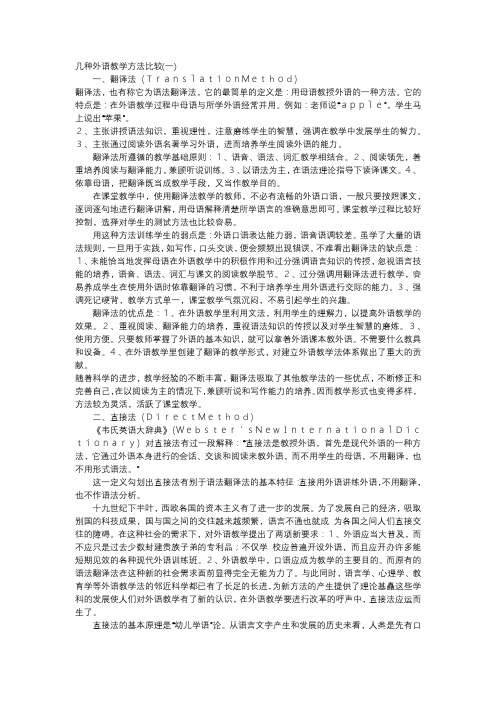
几种外语教学方法比较(一)一、翻译法(TranslationMethod)翻译法,也有称它为语法翻译法,它的最简单的定义是:用母语教授外语的一种方法。
它的特点是:在外语教学过程中母语与所学外语经常并用。
例如:老师说“apple”,学生马上说出“苹果”。
2、主张讲授语法知识,重视理性,注意磨练学生的智慧,强调在教学中发展学生的智力。
3、主张通过阅读外语名著学习外语,进而培养学生阅读外语的能力。
翻译法所遵循的教学基础原则:1、语音、语法、词汇教学相结合。
2、阅读领先,着重培养阅读与翻译能力,兼顾听说训练。
3、以语法为主,在语法理论指导下读译课文。
4、依靠母语,把翻译既当成教学手段,又当作教学目的。
在课堂教学中,使用翻译法教学的教师,不必有流畅的外语口语,一般只要按照课文,逐词逐句地进行翻译讲解,用母语解释清楚所学语言的准确意思即可。
课堂教学过程比较好控制,选择对学生的测试方法也比较容易。
用这种方法训练学生的弱点是:外语口语表达能力弱,语音语调较差。
虽学了大量的语法规则,一旦用于实践,如写作,口头交谈,便会频频出现错误。
不难看出翻译法的缺点是:1、未能恰当地发挥母语在外语教学中的积极作用和过分强调语言知识的传授,忽视语言技能的培养,语音、语法、词汇与课文的阅读教学脱节。
2、过分强调用翻译法进行教学,容易养成学生在使用外语时依靠翻译的习惯,不利于培养学生用外语进行交际的能力。
3、强调死记硬背,教学方式单一,课堂教学气氛沉闷,不易引起学生的兴趣。
翻译法的优点是:1、在外语教学里利用文法,利用学生的理解力,以提高外语教学的效果。
2、重视阅读、翻译能力的培养,重视语法知识的传授以及对学生智慧的磨炼。
3、使用方便。
只要教师掌握了外语的基本知识,就可以拿着外语课本教外语。
不需要什么教具和设备。
4、在外语教学里创建了翻译的教学形式,对建立外语教学法体系做出了重大的贡献。
随着科学的进步,教学经验的不断丰富,翻译法吸取了其他教学法的一些优点,不断修正和完善自己,在以阅读为主的情况下,兼顾听说和写作能力的培养。
语法翻译法-直接法-听说法PPT演示课件
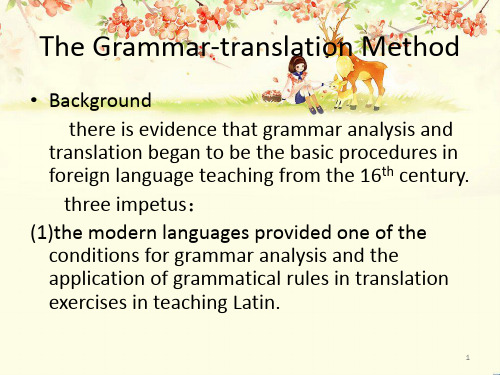
(4)Exemplifcedures for a typical lesson with the Grammar-translation Method can be divided into three phases.
① Phase One : Read and explain the new words and expressions in the first language . Teach the new grammar with deductive method.
The Grammar-translation Method
• Background there is evidence that grammar analysis and
translation began to be the basic procedures in foreign language teaching from the 16th century.
1
(2)the second impetus for the procedures of grammar analysis and translation in teaching Latin came from the social needs of European countries. (3)in the 19th century, more experts of foreign languages teaching adopted the strategy of combining grammar rules with translation.
② Phase Two :reading/translation/analysis/ask questions
对外汉语教学法ppt课件

外国人说的同于母语者所说汉语的有自己系统 的汉语。
(三)汉语教学
Chinese Teaching
有别于“语文教学”,主要是听说读写的能力教学,学 习者原来没有汉语听说能力。美“中文教学”,日“中国语 教学”,韩“中国语教育”。国际场合使用较多。
(四)华语(华文)教学
三、基本特点 (一)汉语特点
1.语音 (1)音节结构
汉语的音节由声韵调构成。
(2)声母 汉语声母可按发音部位和发音方法来分类或分组。
(3)韵母
汉语韵母有单韵母、复韵母、鼻韵母。 (4)音形分离 汉语拼音方案类似音标(只作注音 不作文字)。
2.词汇
(1)双音性 (2)缺乏形态变化 (3)词义引申
3.语法
2.具体影响
(1)综合因素:才能33、智力20、坚持和动力33、其他14 (2)学习方法:迁移(习得经验影响后来学习:正负)、概括(一般事例-普遍规律
:正常概括和过度概括)
(三)教育学
1.理论基础
(1)教育主体观:教师-学生-师生 (2)知识、能力关系:知识-能力-并重 (3)建构主义教学观:原有经验-新的理解
(一)理论基础
1.语言学-机械语言学 2.心理学-官能心理学 3.哲学-唯理主义
(二)教学原则
1.以语法教学为中心,强调系统语法学习。 2.注重书面语,忽视口语。 3.运用学生母语进行课堂教学。 4.以阅读和翻译为主 。
二、直接法(DIRECT METHOD)
直接法是用外语进行外语教学,从而掌握外语口语技能的一种方 法,产生于19世纪后期。
(五)跨文化交际学
1.价值取向
中-群体-中庸和谐;西-个体-权利自由:劝吃、让路
听说法PPT课件

A linguist supervised the learning experience 1) An informant → (a Linguist) + a learner (a native speaker) 2) intensive course 3) small classes of mature and highly motivated
-
15
Oral Approach in the U.S.A
throughout the 1950s
It advocated aural training first, the pronunciation training, followed by speaking, reading and writing.
-
7
Background
The United States entered into World WarⅡ
To supply the U. S. government with personnel who were fluent in languages.
It was necessary to set up special language training program.
ASTP in 1942(Army Specialized Training Program )
-
8
ASTP in the United States
Objective: attain conversational proficiency in a variety of foreign languages.
徐子亮 吴仁甫 实用对外汉语教学法 ppt课件
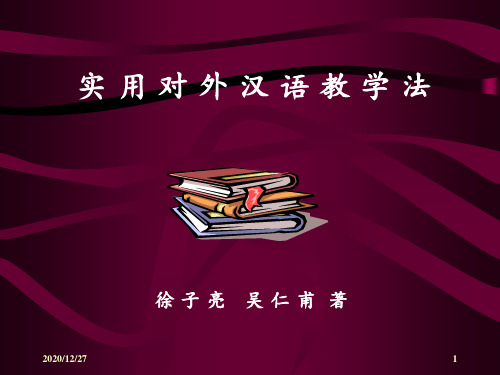
16
5、听说法的教学过程 1)口授语言材料 2)模仿记忆练习 3)句型练习 4)对话 5)读、写练习
6、对听说法的评价 广播教材《英语九百句》 美国麦克米兰公司出版
2020/12/27
17
四、视听法(Audio-Visual approach)
• 视听法是将视觉感受和听觉感受结合起 来进行外语教学的方法
25
2、功能法的理论基础 1)语言学理论基础 2)心理学理论基础
3、功能法的基本原则 1)以单元—学分体系组织语言教学 2)以功能意念为纲,考虑交际要素 3)教学过程交际化 4)基本目的语和专业目的语兼顾
第二章 语言教学法流派介绍
2020/12/27
9
一、语法翻译法
• 语法翻译法是以语法为基础用母语来教授外 语的一种方法
1、语法翻译法的理论基础
2、语法翻译法的教学原则
1)以语法教学为中心,强调系统语法的学习
2)语言材料的内容以突出某种语法形式为准
3)运用学习者母语进行课堂教学
4)以阅读和书面翻译为主
2020/12/27
12
5、直接法的教学方法及过程 教师做动作,配上目的语词语和句子
展示教学内容 教师反复领读词语和句子并正音 操练 看课本认读文字 抄写句子
6、对直接法的评价
2020/12/27
13
三、听说法(Audio-lingual Approach)
• 听说放在首位 先用耳听 后用口说 (audio-oral) 反复口头操练 最终能自动化地运用所学语言材料
汉语的音节由声韵调构成
汉语声母可按发音部位和发音方法来 分类或分组
汉语韵母有单韵母、复韵母、鼻韵母
汉语拼音方案类似音标,只有注音作
主要外语教学法及常用教学技巧 PPT课件
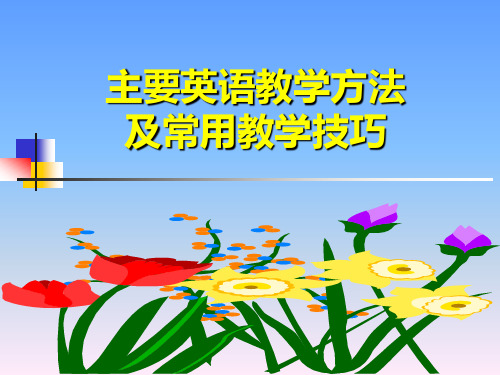
Rain Rain .Go away.
Rain Rain .Go away. Rain rain,go away. Come again another day. Little batty wants to play. Rain .Rain,go away.
Row Your Boat
Row ,row , row your boat. Gently down the stream . Merrily ,merrily, merrily . Life is like /but a dream.
Short vowels: a e i o u
bad, cat, cap, pan, ran bed, hen, let, beg, sell kid, pig, sit, visit, ping dog, hop, hot, lot, lost mum, bump, jump, plum
Vowel Y by, sky, cry, fly, fry, my happy, history, city, lady,
常用教学技巧
实物教学 歌曲教学 儿歌教学 讲故事
图片教学 游戏教学 谜语教学
简笔画教学 表演教学 TPR教学
Give Your Joy Away
Turn your frown upside down . And in a while see your smile, Turn the world around. Give your joy away, your heart can say. Be glad again. In the end , joy will come again. Sing give your joy away ,every girl and boy . Sing ,give your joy away ,never lose your joy. La la la la la la.
外语教学法主要流派及其特点PPT课件
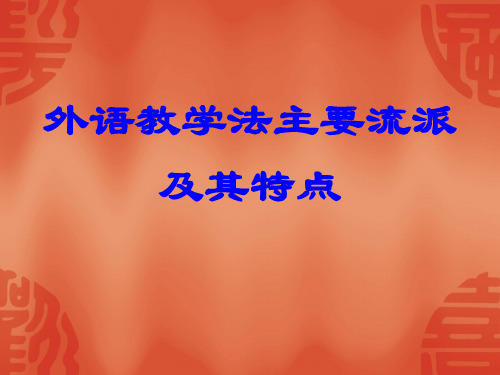
其优点是: 1. 培养学生敢于大胆主动地使用所学语言 进行交谈,口语能力较强; 2. 句型操练对初学者帮助很大,语言规范; 其缺点是: 1. 大量的模仿和机械操练不利于发展学生 的创造性思维; 2. 脱离语言内容和语境的句型操练不利于 学生对语言的灵活运用。 3. 放松读写训练,不利于学生全面发展实 践能力。
其优点是: 1. 有利于培养学生的创造性思维; 2. 在理解语言知识的基础上进行操练, 有利于激发学生的学习兴趣,提高语 言使用的准确性和得体性。 其缺点是: 1. 对语音语调要求不严格; 2. 没有强调培养学生的交际能力。
交际法(Communicative Approach)
交际法也叫功能法(Functional Approach)或意念法 (Notional Approach)。强调以学生为中心,鼓励学生 充分理解和积极参与,体现学生自主的原则。交际学 派认为:语言教学的目的是培养学生使用目的语进行 交际的能力,语言教学的内容不仅要包括语言结构, 还要包括表达各种意念和功能的常用语句。交际法重 视培养学生的语言能力,采用真实、地道的语言材料, 也可从各种书籍或报刊中节选文章或从电影、电视和 广播报道中选取片段等。主张句型加情景来学习语言, 鼓励学生多多接触和使用外语。
翻译法的优点是: 1. 学生语法概念清晰; 2. 阅读能力较强,尤其是遇到长而难的句 子时通过分析句子结构便能理解意思; 3. 有助于培养翻译能力和写作能力。 翻译法的缺点是: 1. 忽视口语教学,学生的语音语调差,不 利于培养学生用外语进行交际的能力; 2. 教学方式单一,学生容易失去兴趣。
直接法(Direct Method)
其缺点是: 1. 排斥母语,使学生对一些抽象和复杂的概念难以理解; 2. 没有明晰的语法解释,对许多语言现象只知其然而不知 其所以然,导致学生说出的话语法错误较多。
对外汉语教学法流派介绍课件

目录
• 对外汉语教学法的历史与发展 • 主要的对外汉语教学法流派 • 教学法流派的特点与优势 • 教学法流派的实践与应用 • 教学法流派的未来发展与挑战
对外汉语教学法的历史与发 展
起源与早期发展
起源
早期发展
随着中国与外部世界的交流增多,越 来越多的外国人开始学习汉语,对外 汉语教学法逐渐发展起来。
20世纪的发现状与趋势
现状
趋势
主要的对外汉语教学法流派
语法翻译法
总结词 详细描述
直接法
总结词
直接用汉语教授汉语,强调模仿和练习
详细描述
直接法主张直接用汉语教授汉语,利用实物、图片等直观教具和肢体语言辅助教 学。它注重口语练习和语音教学,强调模仿和记忆,以及在语境中自然习得语言。
优势
培养学生实际交际能力,提高跨文化 交流水平。
教学法流派的实践与应用
学校教育中的应用
语法翻译法
。
直接法
情景法 任务法
在线教育中的应用
远程教育
利用网络平台进行远程 授课,方便学生随时随
地学习。
在线课程
在线互动
自适应学习
提供丰富的在线课程资 源,包括视频、音频、
文字等。
利用实时聊天、论坛等 工具进行在线互动交流。
听说法
总结词
强调听说技能的培养,通过反复实践练习
详细描述
听说法注重口语练习和听力训练,强调语言的自然习得。它主张通过反复实践练习来培养口语听说能力,注重句 型操练和模仿。
视听法
总结词
详细描述
交际法
总结词
以交际能力为核心,强调语言的实际运 用
VS
详细描述
交际法注重培养学生的交际能力,强调语 言的实际运用。它主张通过真实的语境和 任务设置来促进学生的语言输出,鼓励自 由表达和意义协商。
- 1、下载文档前请自行甄别文档内容的完整性,平台不提供额外的编辑、内容补充、找答案等附加服务。
- 2、"仅部分预览"的文档,不可在线预览部分如存在完整性等问题,可反馈申请退款(可完整预览的文档不适用该条件!)。
- 3、如文档侵犯您的权益,请联系客服反馈,我们会尽快为您处理(人工客服工作时间:9:00-18:30)。
(2)Techniques ① direct association ② questions and answer exercises ③ conversation practice ④ error correction ⑤ dictation
(4)Inductive teaching of grammar
• Theoretical Basis
(1) It negates the dominant role of translation in traditional method and offers an impetus that the direct means should take the place of translation as the main technique in foreign language learning.
(2)the second impetus for the procedures of grammar analysis and translation in teaching Latin came from the social needs of European countries.
(3)in the 19th century, more experts of foreign languages teaching adopted the strategy of combining grammar rules with translation.
② Phase Two :reading/translation/analysis/ask
• Summary and Comments
(1)main advantages
have a better understanding of the meaning of abstract words and complicated sentences.
three impetus: (1)the modern languages provided one of the
conditions for grammar analysis and the application of grammatical rules in translation exercises in teaching Latin.
• Exemplification
Classroom procedures in the Direct Method can be roughly divided into three phases: ①presentation by direct association ②oral practice in the target language ③consolidation with written work
②to provide students with good mental exercise that helps develop their minds.
③to gain a better understanding of the first language.
(3)Techniques ①reading ②translation ③deductive teaching of grammar ④analysis and comparison ⑤memorization ⑥reading comprehension questions ⑦written work
Grammar is by no means taken for granted by
most practitioners of the Direct Method . Instead ,it learned inductively through listening and speaking activities. ①listening comprehension tasks ②graded composition
• Basic Principles
(1)main features ①This method aims at developing the students ability to communicate in the target language. ②Grammar is learned inductively through
(2)theory of learning The theory of learning underlying the
Grammar-translation Method was Faculty Psychology.
• Basic Principles
(1)main features
①Reading and writing are the major focus.
listening and speaking activities. ③ The unit in a language is the sentence.
(2)Objectives
①To foster the students’ ability to communicate in the tation
The main procedures for a typical lesson with the Grammar-translation Method can be divided into three phases.
① Phase One : Read and explain the new words and expressions in the first language . Teach the new grammar with deductive method.
(1) In the mid and late 19th century , European political and economic reasons international exchanges increases much faster than ever before.
(2)The rapid development of linguistics , psychology and education greatly stimulated the establishment of the Direct Method. [Herman Paul , formed the main linguistics base] [W. M. Wundt ,laid the psychological foundation] [J. A . Comenius, ideas on the education justified the views on language teaching with the Direct Method]
(2)Speech patterns rather than grammar should be the fundamental elements of language.
(3)Training in phonetics will enable teachers and students to pronounce the language
③The teacher uses the native language of the students as the main medium of instruction. The teacher emphasizes accuracy rather than
(2)Objectives
①to enable the learners to read and translate its literature.
Three Methods
1204 021202005
陈笑
The Grammar-translation Method
• Background there is evidence that grammar analysis and
translation began to be the basic procedures in foreign language teaching from the 16th century.
foster students ’ ability for reading comprehension and grammatical production.
reading and writing abilities are well trained.
make few demands on teachers.
(2)Disadvantages
never emancipate the learners from dependence on the first language.
cannot not sure that students can use them appropriately in real communicative situation.
• Theoretical Basis (1)theory of language The theory of language underlying the Grammar-translation Method was derived from Comparative Historical Linguistics.
It believes in the natural process of language learning and in the inductive teaching of grammar.
• Background
The Direct Method got its name from the assumption that meaning are to be connected directly with target language , without going through the process of translating into the students’ native language.
